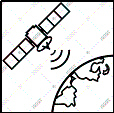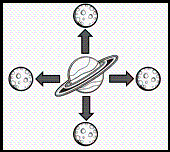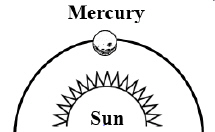Online Assessment
Instructions
1) Type in your first and last name in the
“Name” box in the top-left corner.
2) Next type in your teacher’s last
name in the “ID” box.
3) Then type in your school’s full name in the
“Email” box.
4) Select the best answer for each question.
5) When you
are finished click the “Grade and Submit” button.
6) The grade will be emailed
to your teacher.
|
|
|
1.
|
NOTE: If your teacher’s last
name is Elliott, then you are doing the wrong assessment.
---This assessment is only for
students of other teachers.
---If your teacher is Mr. Elliott, then please go back to the
website and click on the first assessment link instead. Thanks!
Planetary Motion | .
 . . | |
Look at the diagram above showing the motion
of planet Earth. Like all the other planets in our solar system, Earth spins on its own axis.
Identify this motion.
a. | The diagram above is showing how the Earth revolves around the Sun.
| b. | This motion is called a revolution. | c. | The diagram above is showing how the Earth
orbits the Sun. | d. | This motion is called rotation. |
|
|
|
2.
|
Isaac Newton and Albert Einstein studied the forces
and motions demonstrated by planets and moons in our solar system.
Which of the following
choices keeps a moon in orbit around a planet?
a. | shape | b. | size | c. | gravity | d. | composition |
|
|
|
3.
|
What motion do all three
of the celestial objects shown above have in common?
a. | They all move diagonally across the solar system. | b. | They all rotate due
to the force of gravity | c. | They all spin due to the force of
electromagnetism | d. | The Sun revolves around the Earth, and the Earth revolves around the
Moon. |
|
|
|
4.
|
Low Earth Orbit | .
 . . | |
The first satellite was launched into
Low-Earth Orbit (LEO) from Russia in 1957. Today there are over 2000 satellites in orbit. If
somehow the Earth instantly no longer had any mass or gravity, what would happen to all of these
satellites?a. | The satellites would continue to revolve around the Earth, but at a much slower
speed. | b. | All of these satellites would explode in a massive fireball. | c. | The Earth and all
these satellites would immediately fall into the sun. | d. | The satellites would fly off into space in a
straight line away from the Earth. |
|
|
|
5.
|
The following diagram shows the gravitational
interaction between planet Saturn and its largest moon (named Titan). The arrows represent the
direction of Saturn’s gravitational force acting upon Titan.
.

. | |
What is wrong with this diagram?
a. | The orbital path of Saturn around the Sun is displayed
incorrectly. | b. | Titan is not a moon of Saturn. | c. | The arrows are facing the wrong direction.
| d. | Saturn does not have any rings around it. |
|
|
|
6.
|
About every 75 years Halley’s comet completes a circuit around the Sun in
a large elliptical orbit. The Sun and Halley’s Comet | .
 . . | |
What keeps this comet from escaping the
Sun’s orbit?a. | Electromagnetism generated by energized particles in the Sun holds onto the
comet. | b. | The centrifugal force of the comet keeps it from flying off into
space. | c. | Halley’s comet is an artificial satellite. Scientists adjust the thrusters to
keep it in place. | d. | The Sun’s gravitation force keeps
Halley’s comet from flying off into space. |
|
|
|
7.
|
Examine the nine words shown below. Four of these
word are specifically connected with celestial motion, but five of these words are not about this
topic.
Identify three of the five words that ARE NOT specifically about celestial
motion.
a. | Rotation, Revolution, and Orbit | c. | Time, Acids, and Gravity | b. | Meters, Compounds,
and Acids | d. | Rotation, Compounds, and Light |
|
|
|
8.
|
If somehow the gravitation force from these two celestial objects
was removed, what would happen to the Moon?
a. | The Moon would fly off into space in a straight line away from the
Earth. | b. | Both the Earth and the Moon would rotate faster. | c. | The Moon would
continue to revolve around the Earth, but its speed would be slower. | d. | Both celestial
objects would immediately explode due to cosmic friction. |
|
|
|
9.
|
The planet that orbits closet to the Sun is Mercury. The Sun’s gravity
pulls planet Mercury toward it and keeps it from floating away into space. .
 . . | |
What keeps planet Mercury from being pulled
into the Sun?a. | Attractive forces from dark energy. | b. | The Sun’s gravity and planet
Mercury’s gravity. | c. | Earth’s lateral (sideways)
motion | d. | The gravitational force from the other planets. |
|
|
|
10.
|
Saturn’s Rings | 
Saturn | |
Examine the illustration of Saturn displayed above. Notice that Saturn
has rings around it. These rings are made of small rocks and tiny chunks of ice that are held
in place by gravity. Identify the motion demonstrated by Saturn’s rings.
a. | These rings do not have any motion. They are static. | b. | This planet’s
rings are moving upward and downwards due to the solar wind. | c. | Saturn’s rings
are rotating along their own axis but not revolving around the planet | d. | The rings are
orbiting (revolution) around Saturn due to gravity. |
|